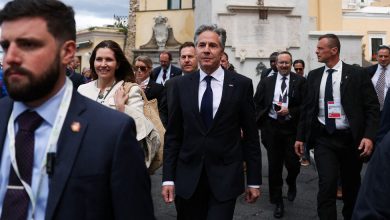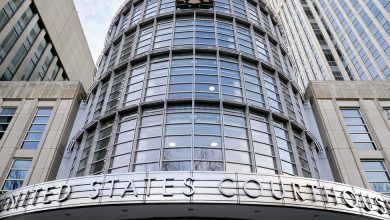A Bellwether for Narendra Modi as India’s Largest State Goes to the Polls

MEERUT, India — An election now underway in India’s most populous state is being closely watched as a referendum on Prime Minister Narendra Modi’s eight years in office, during which he has often pursued a Hindu-first agenda that observers say has empowered his supporters’ polarizing emphasis on religious identity.
Voters in Uttar Pradesh, a largely impoverished state of 200 million people in northern India, say they are concerned about the pandemic-battered economy, with youth unemployment widespread, housing shortages, and the rising cost of food and fuel.
But the governing Bharatiya Janata Party has focused on religion, and on reinforcing new coalitions that have formed around caste, even as tensions between the state’s majority-Hindu population and its minority Muslims have been rising.
The party is apparently counting on that divisive tactic to resonate in Uttar Pradesh, a bastion of the Hindu right, preserving its hold on power in the state and putting it in a favorable position for a general election in two years.
Here’s a look at the major issues as voters in Uttar Pradesh and four other states, from coastal Goa to Uttarakhand on the border with China, go to the polls. Voting takes place over a month; the first set of results are expected March 10.
Religion
In January, Yogi Adityanath, a Hindu monk who is the top official in Uttar Pradesh, laid out in stark terms how his party hoped to define the coming election.
During a TV news interview, Mr. Adityanath, an acolyte of Mr. Modi’s and a potential successor as prime minister, cast the election in terms of “80 versus 20” — a thinly veiled reference to the rough percentage of Hindus in the state compared with Muslims.
Referring to three high-profile Hindu temple development projects in a subsequent interview on state television, Mr. Adityanath said that “these 20 percent are those who oppose Ram Janam Bhoomi, they oppose Kashi Vishwanath Dham, they oppose the magnificent development of Mathura Vrindawan.”
In India, religious and caste identity has long played a part in voters’ political calculations, and Uttar Pradesh is a stronghold of the B.J.P.’s Hindu nationalist ideology.
Still, the backlash to Mr. Adityanath’s remarks was swift. Within days, several high-profile B.J.P. members defected from the party, joining the Samajwadi Party. That party, which is widely seen as representing the interests of the Yadav caste and other disadvantaged castes, has formed an alliance with other, smaller caste-based parties that were historically rivals.
One defector was Swami Prasad Maurya, who as a state cabinet minister focused on the interests of the state’s socially or educationally disadvantaged castes, known in India as “Other Backward Castes,” or O.B.C.s.
“B.J.P. leaders, in the arrogance of power, did not listen, did not give any importance” to minorities’ concerns, Mr. Maurya said.
Some of the smaller O.B.C. groups that helped propel the B.J.P. to power in the last state election, in 2017, also expressed disillusionment. If enough members of these groups vote for opposition parties this time, the B.J.P. may struggle to retain power.
Harmeet Singh, a voter who runs a trucking business in Meerut, an industrial city in western Uttar Pradesh, disapproved of Mr. Adityanath’s framing of the vote in religious terms.
“Why they ask votes in the name of Hindus and Muslims? Why not ask for votes on your performance?” he said.
“We employ both Hindus and Muslims,” he added. “This polarization will hurt the country.”
Economy
The B.J.P.’s focus on religion may not be enough to take voters’ minds off their economic struggles, political analysts said.
Across India, the pandemic has buffeted the economy and people’s confidence in the government. The unemployment rate, which was as low as 3.4 percent in 2017, stood at nearly 8 percent in December 2021, with rates far higher among young people. And even as incomes have fallen for many, inflation has sent prices soaring for staples like tea, meat, cooking oil and lentils.
“There is a change of political discourse. It’s not about mandir and masjid,” said Zoya Hasan, a political commentator, using the Hindi words for temple and mosque. “Economic issues are far more important for people.”
This new focus on the economy among voters in Uttar Pradesh could threaten the B.J.P.’s firm hold on the state, Ms. Hasan said.
“The B.J.P. has all the resources and all the power, but this election seems to be showing that new majorities can be formed,” she said.
As campaigning ended this week, economic issues were foremost on the minds of voters interviewed in western Uttar Pradesh.
“What we want is better public service like good education, good health facilities and employment for our children,” said Surender Yadav, a sugar cane farmer and a member of an O.B.C. group who said he had voted for the B.J.P. in 2017 but would not again.
“These are the basic issues, but there has been no improvement,” he said.
In the city of Modinagar, an opposition candidate, Sudesh Sharma, was showered with flower petals and fed sweets while campaigning.
“You give us employment,” one person in the crowd shouted, “we give you vote.”
Still, many voters perceive the B.J.P. as less corrupt than the opposition parties that were previously in power. They say they are happy with the government’s signature welfare programs in the state, including the distribution of cooking gas cylinders to women, the expansion of food rations and the construction of modest houses of brick and cement.
“B.J.P. is doing good work. Law and order is under control. Girls can go out, roads are good, poor people were given houses,” said Sachin Kumar, a 25-year-old mechanic on the outskirts of Meerut. “We will vote for Yogi and Modi.”
Pandemic and Protest
The elections in Uttar Pradesh and the four other states could also reflect public sentiment on the B.J.P.-led government’s response to the pandemic and to yearlong protests by farmers that extracted a big concession from the usually unyielding Mr. Modi.
A catastrophic second wave of the coronavirus and a halting government response filled hospitals and crematories. At one point, dozens of bodies washed up on the banks of the Ganges River in Uttar Pradesh, presumably victims of Covid-19 dead.
Last March, the government stepped up its response, banning exports of Indian-made vaccines and funneling them into a vaccination campaign that has inoculated more than half of the country’s 1.4 billion people.
But another political challenge emerged when a protest by farmers against a government agricultural overhaul spilled into Uttar Pradesh after encircling India’s capital, New Delhi, for months.
The son of a prominent B.J.P. lawmaker in the state was charged with mowing down a group of demonstrating farmers with his vehicle. Later, after months of deadlock in negotiations with the government, the protesters triumphed, forcing Mr. Modi to ask Parliament to repeal the agricultural measures.
The farmers’ success showed a rare vulnerability in the B.J.P., which has been consolidating power since Mr. Modi first took office in 2014.
The state elections in Uttar Pradesh and elsewhere will reveal whether the party’s recent stumbles are just bumps in the road, or a larger obstacle to retaining power in the world’s largest democracy.
Hari Kumar reported from Meerut, India, and Emily Schmall from New Delhi.




